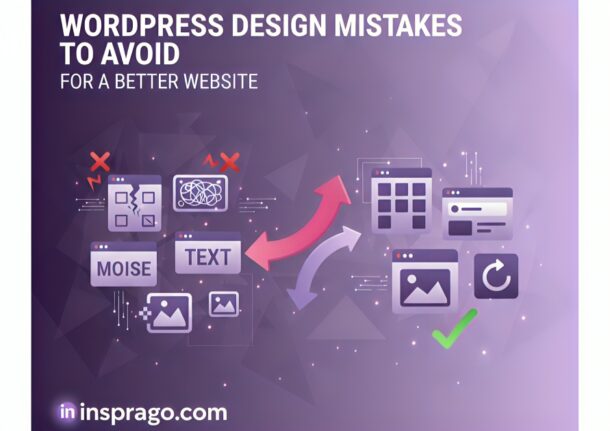Designing a website on WordPress can be exciting, yet it often comes with challenges. While the platform is user-friendly and flexible, many individuals and businesses unknowingly make design errors that negatively affect user experience, search rankings, and brand perception. To ensure your site stands out for the right reasons, it’s crucial to understand the most common WordPress Design mistakes and learn how to avoid them.
Why Avoiding Design Mistakes Matters
Your website is often the first impression visitors have of your business. If it looks cluttered, loads slowly, or feels confusing, users may leave within seconds. Furthermore, search engines now prioritize user experience when ranking websites. Consequently, avoiding mistakes in WordPress Design not only improves aesthetics but also impacts performance, engagement, and conversions.
Overloading with Plugins
One of the most frequent pitfalls in WordPress Design is excessive reliance on plugins. While plugins enhance functionality, too many of them can slow down your site, create security vulnerabilities, and even cause conflicts.
-
Always install only essential plugins.
-
Regularly update and remove unused ones.
-
Test your site speed after adding new plugins.
By maintaining a balance, you can ensure smooth functionality without compromising site performance.
Ignoring Mobile Responsiveness
In today’s mobile-first world, failing to prioritize responsiveness is a major design error. A site that looks amazing on desktop but breaks on mobile can frustrate users and push them away.
Moreover, search engines favor mobile-friendly websites, meaning your ranking could drop if this factor is ignored. To avoid this mistake:
-
Choose responsive WordPress themes.
-
Test on different devices and screen sizes.
-
Optimize images for faster loading.
With these adjustments, your WordPress Design will deliver a consistent experience across all platforms.
Cluttered Layouts and Poor Navigation
Another common issue arises from cluttered layouts. When users land on your site, they should instantly understand where to go. A messy design overwhelms visitors, leading to high bounce rates.
To enhance usability:
-
Stick to a clean, minimalistic layout.
-
Use logical menus and hierarchy.
-
Ensure a clear call-to-action on each page.
Ultimately, simplicity is key. A streamlined WordPress Design makes information more accessible, guiding users smoothly toward their goals.
Neglecting Website Speed
No matter how beautiful your design, if the website loads slowly, visitors will leave. Slow speed is one of the top reasons people abandon websites.
Common causes of poor performance include oversized images, unnecessary scripts, and poor hosting. To fix this:
-
Compress images before uploading.
-
Use caching plugins for faster performance.
-
Select a reliable hosting provider.
When speed improves, user satisfaction rises, and search engines reward your site with better visibility.
Using Generic Stock Images
Images play a central role in building emotional connections. However, overused or irrelevant stock photos can make your site appear untrustworthy. Instead of filling your WordPress Design with generic visuals, invest in unique imagery.
-
Use high-quality original photos.
-
Select visuals that align with your brand.
-
Optimize image size to balance quality and speed.
Authenticity in visuals helps establish credibility and encourages deeper engagement.
Forgetting Accessibility Standards
Accessibility often gets overlooked in design, yet it is vital for inclusivity. A website that is not accessible leaves out users with disabilities, potentially causing legal and ethical concerns.
To ensure compliance:
-
Add alt text for images.
-
Maintain color contrast for readability.
-
Ensure navigation works with screen readers.
By implementing accessibility features, you not only serve all users but also boost your reputation as a responsible brand.
Overlooking Consistency in Branding
Your website should reflect your brand identity consistently. If your fonts, colors, or messaging vary across pages, it can confuse visitors and diminish trust.
Consistency builds recognition. Therefore:
-
Stick to a unified color scheme.
-
Use consistent fonts across all headings and paragraphs.
-
Align tone of voice with your brand personality.
When your WordPress Design aligns with your branding, visitors connect more deeply with your business.
Ignoring SEO Elements
A beautifully designed website is useless if nobody can find it. Neglecting SEO during the design process is another common oversight. Elements like clean code, proper meta descriptions, and optimized headings are essential.
To integrate SEO into your design:
-
Structure content with headings (H1, H2, H3).
-
Add keywords naturally within content.
-
Ensure images include descriptive alt text.
Design and SEO should work hand in hand to achieve both visibility and engagement.
Conclusion
Avoiding these mistakes requires awareness and regular maintenance. A professional team, web design company in Dubai like insprago can help you navigate complexities and achieve a seamless online presence. By prioritizing mobile responsiveness, website speed, accessibility, and consistent branding, you create a platform that not only looks good but also performs effectively. Ultimately, thoughtful WordPress Design is the foundation of success. Therefore, focusing on website design development ensures that your website supports business growth while delivering an exceptional user experience.
FAQs
1. Why is mobile responsiveness critical for a website?
Mobile responsiveness ensures your website adapts to different devices. Since most users now browse on mobile, a non-responsive site can drive away potential visitors and harm search rankings.
2. How can I speed up my WordPress site without compromising design?
You can speed up your site by compressing images, minimizing plugin use, leveraging caching plugins, and selecting reliable hosting. These changes preserve design quality while improving load times.
3. What role does branding play in WordPress Design?
Branding ensures consistency across your website. Unified fonts, colors, and messaging reinforce your identity, build trust, and make your website more memorable to visitors.



















